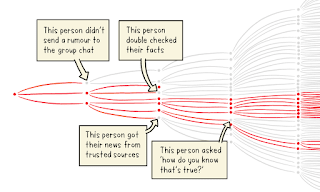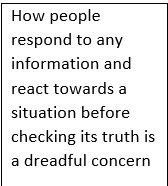Digital Age Infodemic- Boon or Bane
Age of COVID-19 pandemic, January 2020 onwards, witnessed a great deal in terms of health and social values, forced us to overhaul our daily habits and routines, setting trends of new culture and lifestyle in a more conventional approach with the use of methods and beliefs prevailing thirty-forty decades back (daadi ma ke nuskhey aaj zyada samajh aatey hain), contemplating over use of more innovative tools and concepts to tackle the spread of pandemic and above all absence of verification of news and information shared across various social media platforms, websites and channels- having ability to inflict more disastrous effect on the population turning them into a mindless pot of despair.
I, personally, encountered this term 'Infodemic' lately during this pandemic on World Health Organisation's website. It raised more curiosity within to lookout when, what and how this term actually came into existence, and guess what, it was startling to see that the whole world was under the grip of this term. Some of the countries checked the spread of information earlier by regulating strict guidelines whereas others are still under process to do so.
Going deeper into the term on Google search, it defined 'Infodemic' as an overabundance of information both online and offline, where few are deliberately trying to disseminate wrong information to undermine the public health response and advance agendas of groups or individuals.
Google clearly says- mis-and-disinformation can be harmful to people's physical, mental, social and financial health.
In a scientific report published by Nature with the title, 'COVID-19 social media infodemic by M.Cinelli on 06th October, 2020, the author cited the term (Infodemic) as the perils of misinformation phenomena during the management of disease outbreaks. Considering an instance of the incident happened in Lombardy (a region in northern Italy), the international English news channel published an anticipated rumour about the possible lock-down in the region to prevent pandemic. This news was shared and broadcasted prior verification by the official communication, which resulted in overcrowding at train station and airport, disrupted the much-given effort by the government to contain the pandemic.
India witnessed a huge surge in the COVID cases because of the spread of SARS-COV-2's new variant B.1.617. Health infrastructure collapsed in many parts of the country. There occurred massive demand of oxygen concentrators, cylinders, connectors and ventilators. Few conmen took advantage over the situation by sharing wrong information on social media services and extracted surplus amount of money from the victim's family without providing any further support. But there were few, who acted as god-sent messengers from various parts of the country and world to verify each of the links and sources shared on the platforms.
Several such incidents have happened in the past too that had enraged public anger and turned a peaceful region into a bloodbath- communal violence is its name.
In an article, published on PubMed.gov on March 2021 with the title, 'What Social Media told in the time of COVID-19- a Scoping review', the author identifies five overarching public health themes concerning the role of online social media platforms & COVID-19. The themes that were particularly focussed were: Surveying public attitudes, identifying infodemics, assessing mental health detecting or predicting COVID cases, analysing government responses to the pandemic and evaluating quality of health information.
In another paper, 'COVID-19 Infodemic and Indian Media: An Evaluative study' published on a website called Intechopen.com, the content owner cited regarding numerous myths that were busted by the World Health Organisation. Some of the prevailing myths are-
1. Hydroxychloroquine and Chloroquine used for malarial patients can be used to cure COVID-19.
2. Masks should be used during exercise also.
3. COVID-19 is caused by bacteria.
4. Use of mask for longer duration can cause CO2 intoxication
5. Alcohol consumption can prevent from COVID-19.
6. Thermal scanners can identify COVID-19 infection.
7. COVID-19 is transmitted through flies.
8. 5G mobile networks are spreading COVID-19.
10. Sun exposures prevent from COVID-19 (though exposure to sunlight has its own benefits).
11. Pneumonia vaccines prevent from COVID-19.
12. Garlic consumption reduces the risk of COVID-19.
Another important highlights that the paper stressed on how several Indian news channels (Hindi & English) at times carried 2-3 major information topics identified by the WHO. New channels as of now is the most active medium besides YouTube, Facebook, Twitter & WhatsApp for absorbing news. It has a vital role to play regarding awareness on authentic information.
For COVID-19, social media and all other active platforms can have a crucial role in disseminating health information and tackling infodemic & misinformation.
A layman must use his/her common senses regarding the authenticity of all the information he/she is receiving from others on social media outlets. Looking out for the source of the information is important. One can also confirm it from experts. Reading beyond headlines is crucial, as it would help people not to fall for wrong information.
Well, a proper regulatory body must be established to contain or filter misinformation from various social media services; verifying information shared across different platforms or developing a software tool that can check the credibility of the information, sending warning signals across multiple platforms.
The World Health Organisation is a trusted source for COVID-19 information. So, is the Indian government's MOHFW website that keeps on releasing materials related to COVID in days and week.
In one of the WHO findings, nearly 43.9 percent (both male and female) would likely shared scientific content for its reliability ratio whereas in a similar finding, it came out that around 59.1 percent of Gen Z and millennials surveyed were almost aware of the spread of fake news but identification of the sources to counter the news became challenging for them.
In one of its latest news articles, published on April 27th 2021, the WHO cited the causal effect over the spread of coronavirus misinformation. Around 6000 people across the globe were hospitalised in the first three months of 2020 and at least 800 people may have died because of the exchange of wrong information on COVID-19.
In this Digital era, where things are turning very fast and in friction of seconds news spread from one corner of the world to the other, creating uncertainty in the mind and behaviour of the population through wrong and harmful content could fuel skepticism & distrust and could target a larger size of population who are unaware about its intensity resulting into fear, anxiety, stigma, violence etc across regions.
In a local incident happened lately in Barabanki district of Uttar Pradesh ( a northern region of India), villagers jumped into the river just to escape from health workers, who were encouraging them to get vaccinated. This is just one-of-its-kind health tragedy happening in rural villages of the country where misinformation has been overloaded in the minds of the people by certain malefactors, who want to establish their own agendas for the sake of their own ideologies.
Indian government's COVID-19 based app, 'Arogya Setu' and its websites 'MyGov' are turning out to be great social media influencers sharing real-time data and information over the availability of hospital beds, testing sites and vaccination centres.
Information sharing and absorbing lies in our own hands and we have to choose whether we would want to be called creators or destroyers.
#COVID-19 #Infodemic #FakeNews #SocialMediaPlatforms #MyGov #ArogyaSetu #WHO #Mythbusters
By- Rashmi Singh
Image: World Health Organisation




.jpg)

Comments
Post a Comment